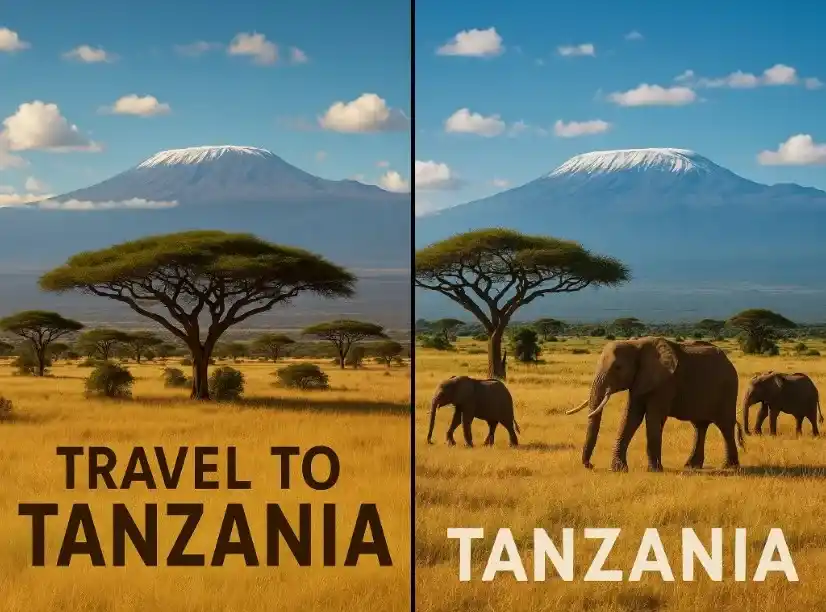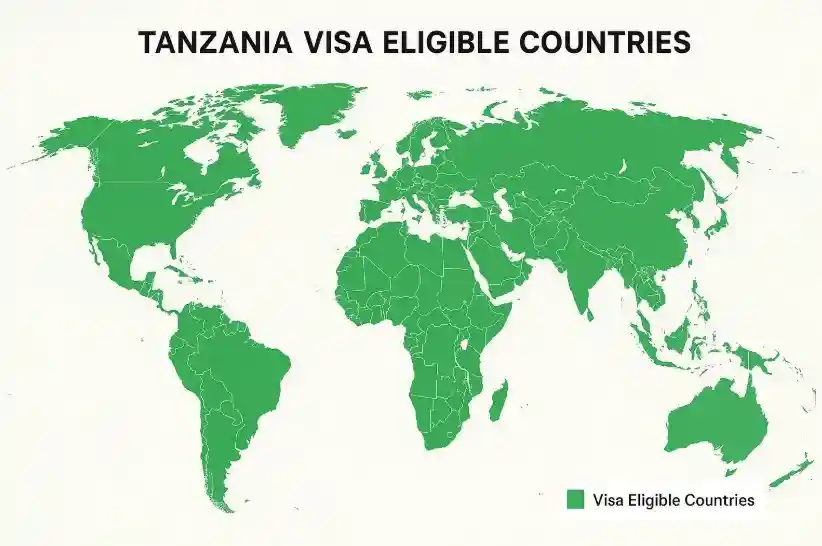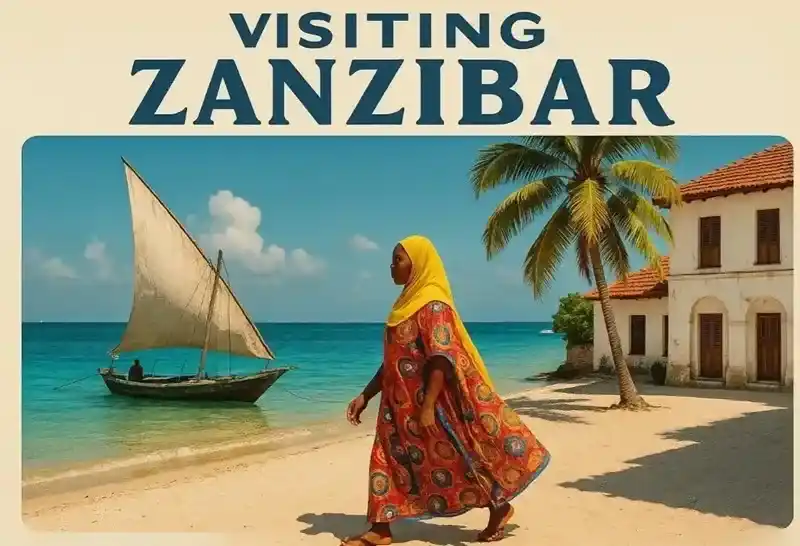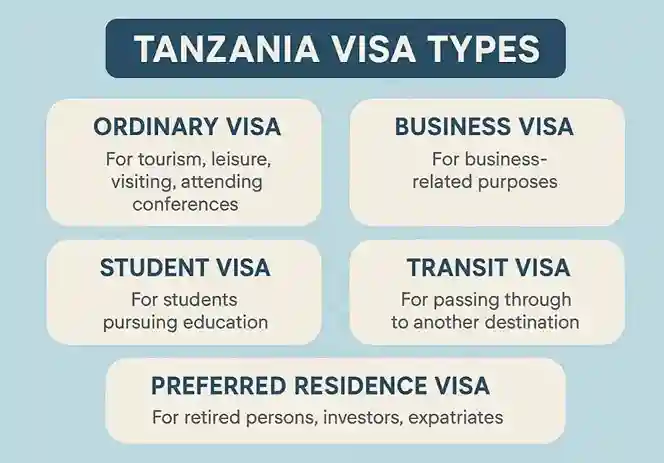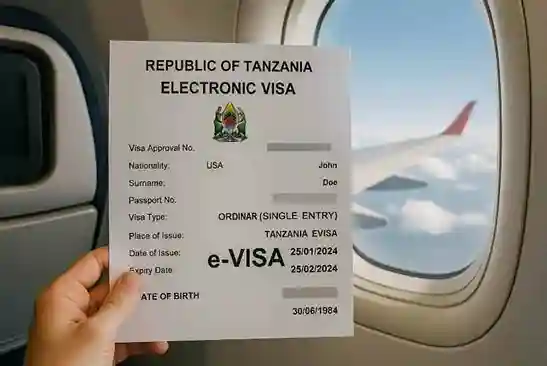Top Safari Destinations in Tanzania
Tanzania is a dream destination for nature lovers and adventure seekers. From witnessing lions hunt on the Serengeti plains to diving in Zanzibar’s turquoise waters, or standing on Africa’s roof at Kilimanjaro, this East African gem offers an incredible variety of travel experiences.
1. Serengeti National Park
The Serengeti National Park is one of the most famous wildlife reserves in the world — a must-see if you’re visiting Tanzania.
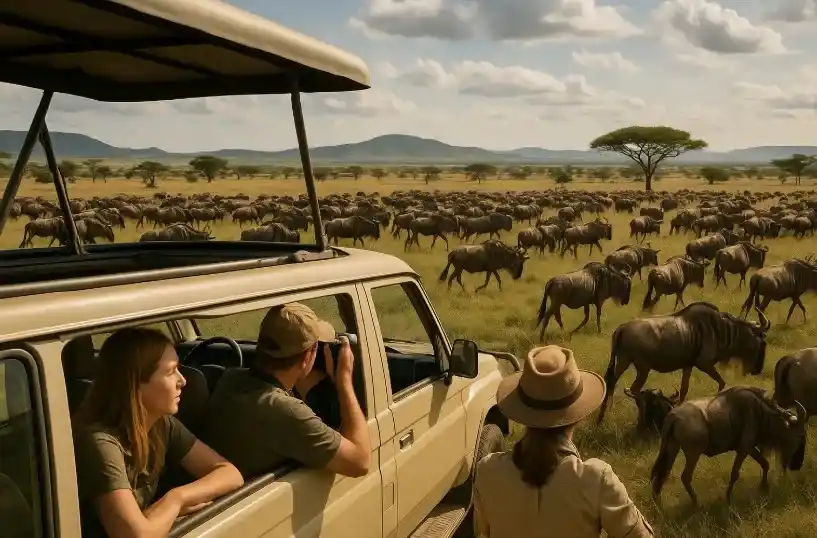
- Famous for the Great Wildebeest Migration.
- Home to the Big Five (lion, leopard, elephant, buffalo, rhino).
- Perfect for safari game drives and hot-air balloon safaris.
- Location: Northern Tanzania, bordering Kenya’s Maasai Mara Reserve
- Size: ~14,750 km² (about the size of Northern Ireland)
- UNESCO World Heritage Site (since 1981)
- Known for the Great Migration — over 1.5 million wildebeest, 250,000 zebras, and thousands of gazelles moving in search of fresh grazing
- Serengeti National Park Highlights
- The Great Migration (year-round movement, best seen Dec–July in Tanzania)
- Big Five: Lion, Leopard, Elephant, Buffalo, Rhino
- Predator action: High density of lions, cheetahs, and hyenas
- Scenery: Endless savannah, kopjes (rock outcrops), acacia trees
- Serengeti National Park Main Regions
- Seronera Valley: Heart of the park, year-round wildlife, excellent for big cats
- Western Corridor (Grumeti River): Famous for dramatic wildebeest river crossings (May–July)
- Northern Serengeti (Mara River): Best for July–Oct migration crossings into Kenya
- Southern Plains (Ndutu area): Calving season (Dec–March) with baby wildebeest — predators follow
- How to Get Serengeti National Park
- By Air: Small charter flights from Arusha, Dar es Salaam, or Zanzibar into Serengeti’s airstrips (Seronera, Kogatende, Grumeti, Ndutu)
- By Road: 6–8 hours’ drive from Arusha (via Ngorongoro Crater) — bumpy but scenic
- Accommodation: Luxury lodges: Four Seasons Safari Lodge, Singita, &Beyond. Tented camps: Permanent or mobile (follow migration routes).
- Accommodation Budget options: Campsites & simpler lodges near park gates (Ikoma, Seronera)
- Serengeti National Park Park Fees (2026)
- Adults (non-resident): $70 per day (high season), $60 (low season)
- Children (5–15 yrs): $20–$25 per day
- Vehicle & camping fees apply if self-driving
- Best Time to Visit to Serengeti National Park
- Dec–March: Calving season in Ndutu (predators active)
- May–July: Grumeti River crossings
- July–Oct: Mara River crossings (northern Serengeti)
- Nov–Dec: Short rains, lush landscapes, fewer crowds
2. Ngorongoro Crater
The Ngorongoro Crater is one of Tanzania’s most spectacular natural wonders — often called the "Eighth Wonder of the World"
The Ngorongoro Crater is usually included as part of a Northern Tanzania safari circuit (Tarangire → Lake Manyara → Ngorongoro → Serengeti).
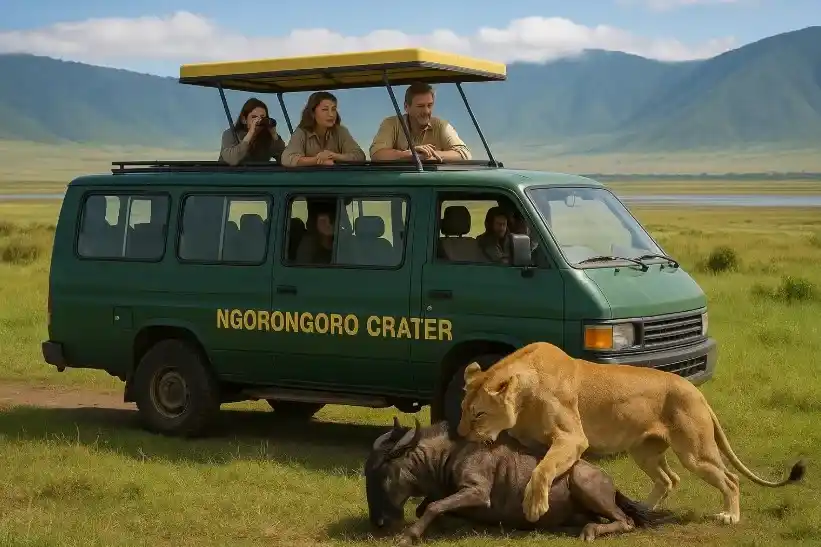
- A UNESCO World Heritage Site.
- World’s largest unbroken volcanic caldera.
- Dense concentration of wildlife — ideal for photography safaris.
- Location: Northern Tanzania, about 180 km west of Arusha
- Type: Volcanic caldera formed ~2–3 million years ago when a giant volcano collapsed
- Size: ~260 km² floor, 610 m deep, 20 km across
- UNESCO World Heritage Site since 1979
- Part of the Ngorongoro Conservation Area (NCA), which also includes Olduvai Gorge and part of the Serengeti ecosystem
- Ngorongoro Crater Wildlife
- The crater is like a “natural zoo” with an incredible density of animals:
- Big Five: Lion, Leopard, Elephant, Buffalo, Rhino (black rhino sightings are a highlight here)
- Large herds of zebra, wildebeest, gazelle, eland
- Hippos wallowing in lakes
- Over 500 bird species, including flamingos at Lake Magadi
- Unlike the Serengeti, most animals here stay year-round due to the rich grazing inside the crater.
- Ngorongoro Crater Highlights
- Black Rhinos: One of the best places in East Africa to spot them
- Ngorongoro Lions: Famous for large prides
- Olduvai Gorge: Archaeological site where early human fossils were discovered
- Cultural Visits: Maasai communities still live and graze cattle around the crater rim
- Ngorongoro Crater Fees (2026, Non-Residents)
- Conservation Area Entry: $70 per adult / day
- Crater Descent Fee (per vehicle, <5 seats): $295 per day
- Children (5–15 yrs): ~$20 entry
- (Fees are separate from Serengeti National Park’s)
- Best Time to Visit
- Best Time to Visit to Ngorongoro Crater
- Dry season (June–Oct): Best wildlife viewing, clear skies, easier driving
- Wet season (Nov–May): Fewer tourists, lush scenery, birdwatching at its peak (esp. March–May)
- Getting Ngorongoro Crater: By Road: ~3–4 hours from Arusha (common stop on safari route). By Air: Small charter flights to Lake Manyara Airstrip, then ~1.5 hr drive to crater
- Ngorongoro Crater Accommodation
- Luxury lodges: Ngorongoro Crater Lodge (by &Beyond), Neptune Ngorongoro
- Mid-range: Rhino Lodge, Sopa Lodge
- Budget: Campsites around Karatu town (outside the conservation area)
3. Zanzibar Island
Zanzibar itself isn’t a safari destination like the Serengeti or Ngorongoro — it’s an island paradise famous for white-sand beaches, spice farms, and Stone Town’s history.
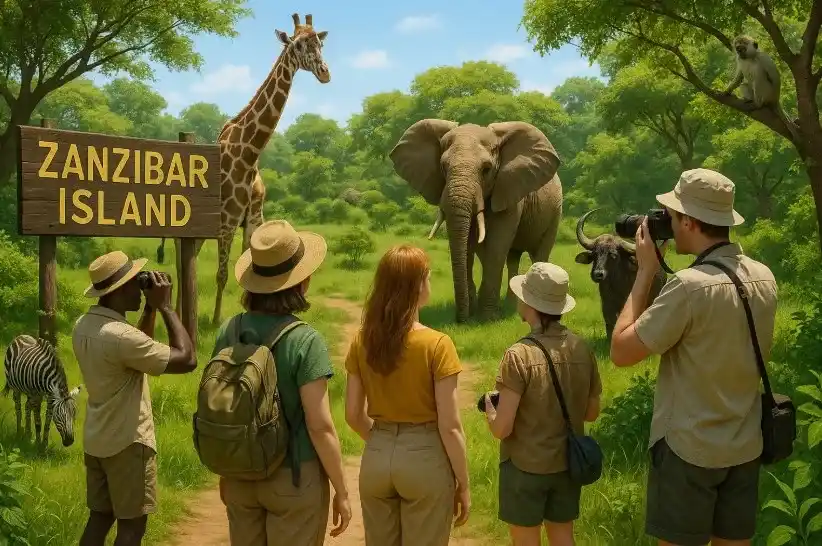
A Zanzibar extension after safari is the classic way to end a Tanzanian adventure — lions and elephants first, then cocktails by the Indian Ocean.
- Most travelers do a “Bush & Beach Safari”:
- Safari on the mainland (Serengeti, Ngorongoro, Tarangire)
- Beach relaxation on Zanzibar afterward
- Getting to Zanzibar: Flights from Mainland: Arusha, Serengeti airstrips, or Dar es Salaam → Zanzibar (ZNZ airport)
- Getting to Zanzibar: Ferry: Dar es Salaam → Zanzibar (~2 hours)
- Where to Stay in Zanzibar
- Luxury: Park Hyatt Stone Town, Baraza Resort & Spa, The Residence
- Mid-range: Zanzibar Queen Hotel, Zuri Zanzibar
- Budget: Paje hostels, small beach bungalows
- Zanzibar Travel Tips
- Visa covers both mainland Tanzania and Zanzibar (no extra visa needed)
- Zanzibar introduced a mandatory $44 health/travel insurance fee (added to entry)
- Best time: June–Oct (dry season) or Dec–Feb for perfect beach weather
4. Mount Kilimanjaro Tanzania | Trekking Routes, Tours & Climbing Guide
Climb Mount Kilimanjaro, Africa’s highest peak. Discover trekking routes, best time to climb, climbing tips, and book Kilimanjaro hiking tours with expert guides in Tanzania.
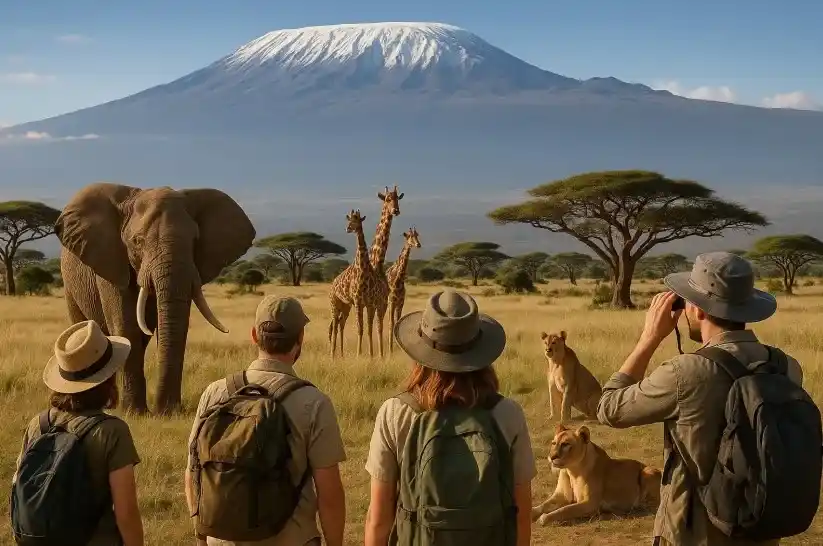
Mount Kilimanjaro – Climb Africa’s Tallest Peak
Standing at 5,895 meters (19,341 ft), Mount Kilimanjaro in northern Tanzania is the highest mountain in Africa and the world’s tallest free-standing mountain. Known as the “Roof of Africa”, Kilimanjaro is one of the most iconic trekking destinations on Earth.
It is a UNESCO World Heritage Site, famous for its snow-capped peak, diverse ecosystems, and accessibility — no technical climbing required, making it ideal for adventurers of all levels.
Kilimanjaro Climbing Routes
There are 7 main trekking routes to the summit, each offering different landscapes and difficulty levels:
Mount Kilimanjaro Popular Routes
- Marangu Route (5–6 days): Known as the Coca-Cola Route, with hut accommodations
- Machame Route (6–7 days): The Whiskey Route, scenic and popular with hikers
- Lemosho Route (7–8 days): Remote, beautiful, high success rate
- Rongai Route (6–7 days): Approaches from the north, quieter trail
- Northern Circuit (9 days): Longest route, best acclimatization & summit success
Shorter & Less Common Routes
- Shira Route (7–8 days)
- Umbwe Route (5–6 days, steepest and toughest)
Best Time to Climb Kilimanjaro
- January–March: Clear skies, colder nights, fewer crowds
- June–October: Dry season, most popular, warm days and great views
- April–May & November: Rainy seasons, fewer climbers but tougher conditions
Wildlife & Nature on Kilimanjaro
Climbing Kilimanjaro takes you through 5 distinct climate zones:
- Bushland/Savannah – wildlife like colobus monkeys & birds
- Rainforest – lush, green, tropical forest
- Heather/Moorland – giant lobelias, unique alpine plants
- Alpine Desert – rocky, barren landscapes
- Arctic Summit – glaciers and snowfields at Uhuru Peak
Accommodation on Kilimanjaro
- Mountain Huts (Marangu Route) – shared dormitories with basic facilities
- Tented Camps (All other routes) – full-service camping with porters and cooks
Tips for Climbing Kilimanjaro
- Acclimatization: Choose longer routes for higher success rates
- Fitness: No technical skills required, but good stamina is essential
- Guides & Porters: Required by Tanzanian law for safety and support
- Gear: Warm clothing, trekking poles, sleeping bag, headlamp, hydration system
Sample Kilimanjaro Trekking Itinerary (7 Days Machame Route)
- Day 1: Arrival in Moshi/Arusha
- Day 2: Machame Gate → Machame Camp
- Day 3: Shira Plateau Camp
- Day 4: Barranco Camp
- Day 5: Karanga Camp
- Day 6: Barafu Camp → Midnight summit push
- Day 7: Uhuru Peak → Mweka Camp → Descent
FAQs – Mount Kilimanjaro Climb
- Q1: Do you need experience to climb Kilimanjaro? No technical climbing is required. Anyone with good fitness and determination can summit.
- Q2: How long does it take to climb Kilimanjaro? Between 5 to 9 days, depending on the route.
- Q3: Is climbing Kilimanjaro dangerous? It’s safe with professional guides, but altitude sickness is a risk. Choosing longer routes increases success.
- Q4: What is the success rate for Kilimanjaro climbs? Short routes (5–6 days): ~50–60% success. Longer routes (7–9 days): ~85–90% success.
- Q5: How much does a Kilimanjaro climb cost? Average: $1,800 – $3,500 depending on the route, service level, and number of days.
5. Tarangire National Park Tanzania | Safari, Wildlife & Tours
Discover Tarangire National Park in Tanzania, famous for elephants, baobab trees, and rich wildlife. Plan your Tarangire safari tours, lodges, and travel itineraries today.
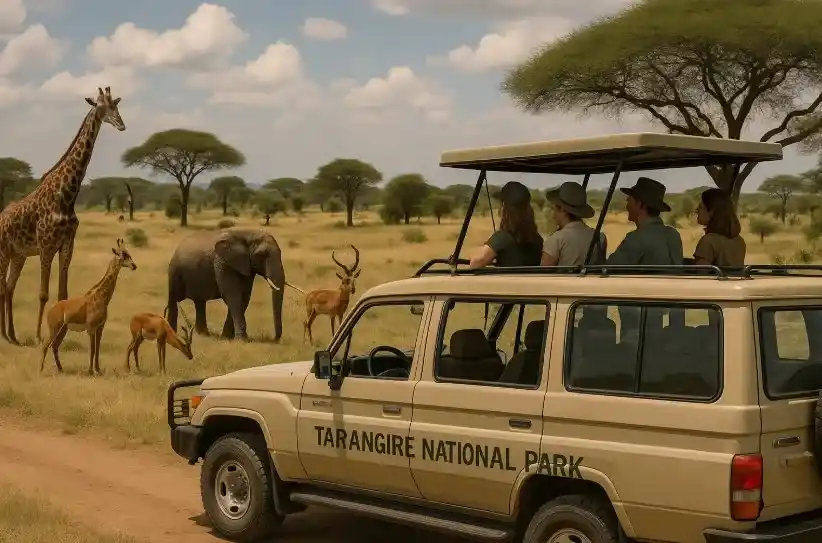
Tarangire National Park – Tanzania’s Elephant Paradise
About Tarangire National Park: Located just two hours from Arusha, Tarangire National Park is one of Tanzania’s most beautiful safari destinations. Covering 2,850 km², it is renowned for its massive elephant herds, ancient baobab trees, and seasonal migration of wildebeest and zebras.
Wildlife in Tarangire
Tarangire is a biodiversity hotspot, home to rare species and classic safari wildlife.
What Animals Can You See?
- Elephants – one of the largest populations in East Africa
- Lions & leopards – big cats often spotted near the river
- Wildebeest & zebras – seasonal migration herds
- Birds – over 550 species, including ostriches, hornbills & lovebirds
- Rare antelopes like fringe-eared oryx, gerenuk, and greater kudu
Landscape & Scenery
Tarangire is known for:
- Iconic baobab trees dotting the savannah
- The Tarangire River, a vital water source attracting wildlife in the dry season
- Rolling plains, acacia woodlands, and seasonal swamps
Safari Experiences in Tarangire
- Game Drives: Morning & evening drives for elephants, lions & giraffes
- Walking Safaris: Guided bush walks (available in some lodges)
- Night Game Drives: Spot nocturnal wildlife in private concessions
- Birdwatching Safaris: Perfect destination for avid birders
Lodges & Camps in Tarangire
- Luxury: Tarangire Treetops, Oliver’s Camp, Lemala Mpingo Rid
- Mid-range: Tarangire Safari Lodge, Maramboi Tented Camp
- Budget: Public campsites & affordable tented camps near the gate
Best Time to Visit Tarangire
- Dry Season (June–October): Best wildlife viewing, animals gather around the river
- Wet Season (Nov–May): Lush landscapes, fewer crowds, excellent birdwatching
Safari Itineraries Including Tarangire
Tarangire is often part of the Northern Circuit Safari:
Arusha → Tarangire → Lake Manyara → Ngorongoro Crater → Serengeti
- 3 Days: Tarangire only (short safari)
- 5 Days: Tarangire + Ngorongoro + Serengeti
- 7–8 Days: Full Northern Circuit
FAQs – Tarangire National Park
- Q1: Why is Tarangire National Park famous?
- For its large elephant herds, baobab trees, and seasonal wildlife migration.
- Q2: How far is Tarangire from Arusha? About 120 km (2 hours by road).
- Q3: What is the best time to visit Tarangire? The dry season (June–October) is best for game viewing.
- Q5: Is Tarangire part of the Great Migration? Not the Serengeti-Mara migration, but it has its own seasonal migration of wildebeest, zebras, and antelopes.
- Q4: Can you do a day trip to Tarangire? Yes, it’s close enough from Arusha or Moshi for a day trip safari.
6. Lake Victoria & Mwanza Tanzania | Travel Guide, Tours & Safaris
Explore Lake Victoria and Mwanza, Tanzania’s vibrant “Rock City.” Discover Rubondo Island, fishing tours, cultural heritage, and nearby Serengeti safaris. Plan your Lake Victoria adventure today!
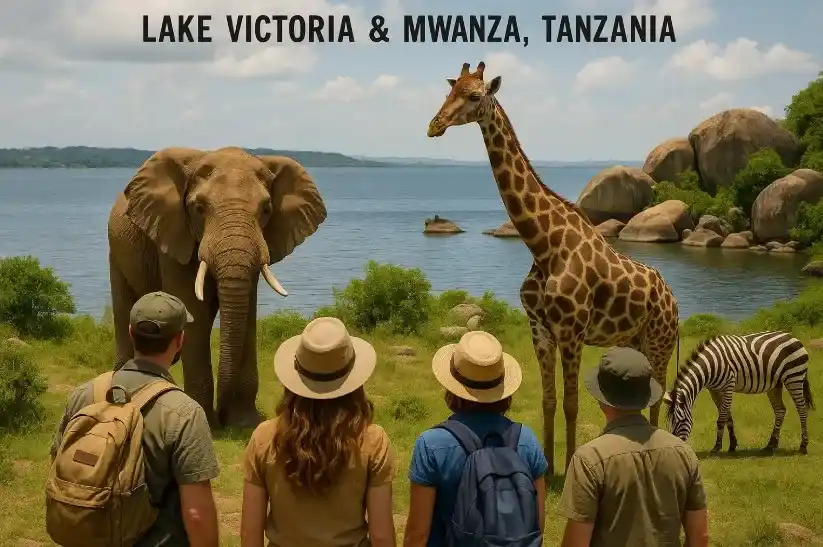
Lake Victoria is Africa’s largest freshwater lake and the world’s largest tropical lake, shared by Tanzania, Kenya, and Uganda. It’s the source of the Nile River and home to rich biodiversity, from Nile perch and tilapia to hippos, crocodiles, and hundreds of bird species.
- Activities: Fishing safaris, birdwatching, cultural village tours
- Islands: Rubondo Island National Park, Ukerewe Island
- Highlights: Stunning sunsets, island-hopping, traditional fishing villages
Mwanza – Tanzania’s “Rock City”
Located on Lake Victoria’s southern shore, Mwanza is Tanzania’s second-largest city and a hub for trade, culture, and tourism. It’s famous for giant granite boulders scattered across the landscape.
Top Attractions in Mwanza
- Bismarck Rock – Mwanza’s landmark balancing rock on Lake Victoria
- Saanane Island National Park – spot antelope, monkeys, and monitor lizards just minutes from downtown
- Sukuma Museum (Bujora) – experience the culture of Tanzania’s largest ethnic group
- Lake Cruises – sunset boat rides and island excursions
- Rock City Mall – modern shopping and dining
Islands & Excursions from Mwanza
Rubondo Island National Park 🐘 – Tanzania’s only island park, with elephants, giraffes, chimps, and excellent birdlife
Ukerewe Island 🚲 – the largest island in Lake Victoria, perfect for cycling, village stays, and cultural immersion
Mwanza & Serengeti Connection
Mwanza is a gateway to the Western Serengeti, especially during the Great Migration (June–July) when wildebeest cross the Grumeti River. Many travelers combine: Serengeti Safari → Mwanza City → Lake Victoria Islands
How to Get to Mwanza
- Flights: Daily from Dar es Salaam, Arusha, Kilimanjaro, and Serengeti airstrips
- By Road: 8–9 hrs from Arusha, 17–18 hrs from Dar
- By Ferry: Services to Bukoba, Musoma, and Ukerewe Island
Accommodation in Mwanza & Lake Victoria
- Luxury: Malaika Beach Resort, Gold Crest Hotel
- Mid-range: Hotel Tilapia, Isamilo Lodge
- Budget: Guesthouses & hostels near the city and ferry port
Best Time to Visit
- June–October: Dry season, best for combining with Serengeti safaris
- November–May: Green season, lush landscapes, great for birdwatching
- FAQs – Lake Victoria & Mwanza Travel
- Q1: Is Mwanza worth visiting? Yes! Mwanza combines lakeside relaxation, unique rock formations, rich Sukuma culture, and easy access to the Serengeti and Rubondo Island.
- Q2: What is Mwanza famous for? Mwanza is known as Rock City for its granite boulders, its location on Lake Victoria, and its cultural diversity.
- Q3: Can I do a safari from Mwanza? Yes. Mwanza is a gateway to the Western Serengeti and Rubondo Island National Park.
- Q4: How do I reach Lake Victoria’s islands? Ferries and boats connect Mwanza to Ukerewe and Rubondo Islands, with charter flights also available.
7. Dar es Salaam
Dar es Salaam itself is a coastal city — Tanzania’s commercial capital — so it isn’t a safari destination. But it’s a perfect starting point for exploring southern Tanzania’s wildlife parks, which are more remote and less crowded than the Serengeti/Ngorongoro circuit in the north.
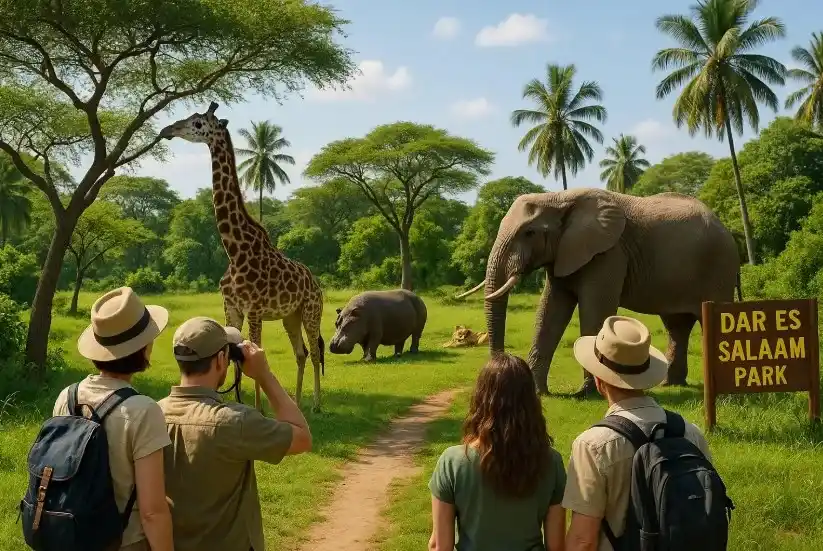
- Selous Game Reserve (Nyerere National Park)
- One of Africa’s largest protected areas (30,000+ km²)
- Known for boat safaris on the Rufiji River (hippos, crocs, birdlife)
- Huge elephant herds, wild dogs, lions, giraffes, buffalo
- 45-min flight or 4–5 hr drive from Dar es Salaam
- Closest safari park to Dar (about 4–5 hrs by road)
- Great for short safaris: zebras, giraffes, wildebeest, lions
- Scenic backdrop of the Uluguru Mountains
- Best option for 2–3 day trips from Dar
- Tanzania’s largest national park (~20,000 km²)
- Famous for lion prides and big predators
- Strong elephant populations
- 2-hr flight from Dar; by road, very long (9–10 hrs)
- Best for a longer, more exclusive safari
- More about hiking & waterfalls than game drives
- Endemic monkeys, rare birds, lush rainforest
- 6–7 hrs by road from Dar
- Fly-in safaris: From Dar es Salaam Airport (DAR) you can take bush flights into Selous, Ruaha, or Serengeti.
- Road safaris: Mikumi and Selous can be reached by car — good for shorter or budget trips.
